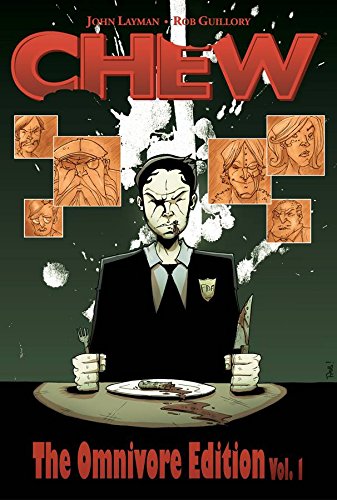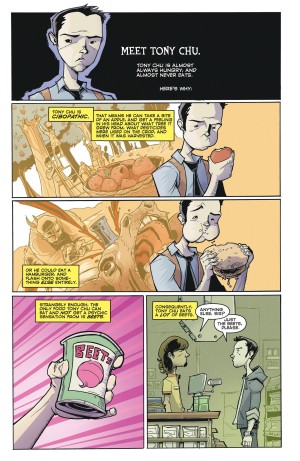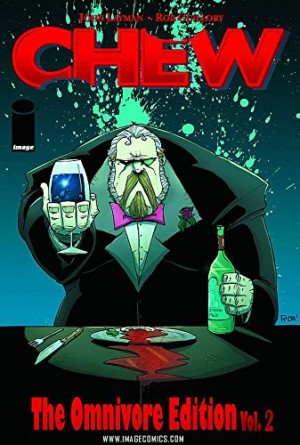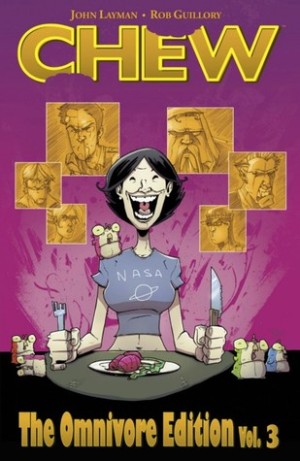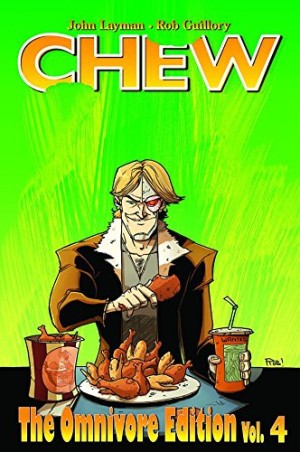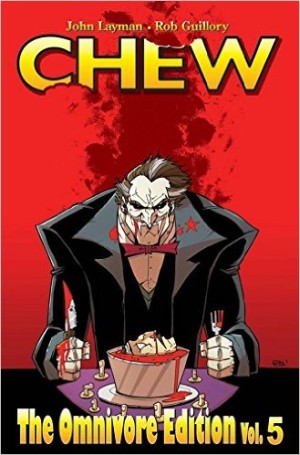Review by Karl Verhoven
So, you’ve heard over and over that Chew is pretty good, so why would you want to start with this expensive hardcover edition when the two paperbacks it combines are cheaper?
Originally packaged as Taster’s Choice and International Flavor, the lead character here is Tony Chu. Although he doesn’t start that way, for most of the series he’s an agent for the Food and Drugs Agency whose powers have been beefed up after 23 million Americans died in a bird flu epidemic. Poultry is now illegal, and Philadelphia policeman Chu and his gung-ho partner John Colby are investigating an illegal chicken restaurant. Chu, though, has an advantage not available to most detectives. He’s a cibopath, able absorb the history of anything he eats. In the case of illegally raised chicken this talent provides the clues leading to arrests.
For Chu the talent is double-edged, providing unwanted information with every mouthful of food, so he tends to avoid eating much other than beetroot, for some reason impervious to his abilities. John Layman consistently plays about with this idea, later investigating gruesome applications, and introducing numerous other characters with wacky food-related powers. Never write anyone off, as very few have ever served their purpose at the end of a story.
Neither creator was a household name when they began working on Chew. Layman had some lesser Marvel work under his belt, and Rob Guillory’s professional experience was even briefer, but given the freedom to express their own viewpoint, both flourished. It’s hard to write comedy that’s sustained as genuinely funny. Among all forms of commercial writing it’s the most highly prized talent, yet Layman pulls it off, and Guillory’s obviously having a ball. Part of what makes Chew so immensely readable is the sheer elastic joy of his art. It’s packed with visual gags, and you’ll notice something previously missed every time you look.
The opening chapters are all individual tales, but confident the series would continue, Layman and Guillory stretch themselves over the following material. Chu, now with the FDA, is sent to the remote Polynesian island of Yamapalu where chicken is seemingly being served. It introduces one of the series best and most surprising characters, Poyo, the fighting chicken. His introduction is relatively tame, but Guillory would go on to produce spread after excellent spread featuring Poyo.
Also introduced is one of Layman’s regularly appealing tricks as he dots about to the areas where Chu is missing: “A routine valve inspection in the city sewer system yielded a disturbing discovery.” These pages break up the narrative, supply a few good jokes, and allow Guillory some expressive freedom that’s not locked in.
So why buy the hardcover editions? Because the series is a keeper. This is something you’ll want to come back to. Like the well-oiled sitcom you always settle on when zapping through the TV channels, there’s a comfort in a job well done in providing laugh after laugh in an unpredictable plot, while simultaneously making you care about the cast. Better still, there’s no jumping the shark moment in Chew. It’s the original creative team of Layman and Guillory from start to finish, not assorted extra ‘producers’ added after focus testing and diluting their concepts. And the material in this book picked up both Eisner and Harvey awards. Yes, there’s a bonus sketch and design section, but the quality of the strips is what counts.
